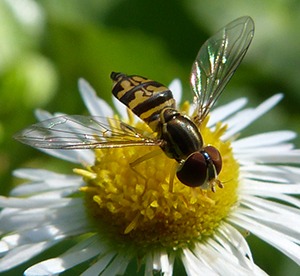
When is a bee not a bee? When it is a hoverfly! Hoverflies are flies that look like bees or wasps. Their disguise is very good and casual observers often mistake them for small bees or wasps. Hoverflies, also known as Syrphid flies or flower flies, are found on every continent except Antarctica. They belong to the family Syriphidae and there are approximately 6,000 species of hoverflies. Several species are native to Kentucky.
Like their look-a-likes, hoverflies are important pollinators. However, unlike their look-a-likes, they rarely get the recognition they deserve. The adult hoverflies feed on nectar and pollen. They can often be found hovering above or perched on a flower. It is thought their hovering behavior might help them avoid the many predators like spiders and assassin bugs that hide among the flowers waiting for unsuspecting prey.
The hoverfly larva or maggots are aphid predators. The adult female hoverfly will lay her eggs on a plant with aphids. After a few days the egg hatches and a larva emerges. One researcher reported that a single hoverfly larva could eat over 30 aphids in a single day! Because hoverfly larva can eat so many aphids, some places are starting to use hoverflies for biological controls in the same way that ladybugs are sometimes used to control aphids.
So how can you tell whether the “bee” you see on the flower next to you or hovering over your arm is really a bee or just a hoverfly? Perhaps the easiest way is to look at its face. Hoverflies have giant “fly eyes” that cover most of their face. Bees have much smaller eyes in proportion to their heads. Hoverflies also have one set of wings, while bees have two sets of wings. Being able to quickly tell how many wings the insect in question has comes with practice. However, once you “get it,” it becomes a very reliable and quick method of distinguishing between flies and bees at a distance. Another method is to look at the antennae – bees also have longer antennae than hoverflies.
So next time you see a bee at your flowers, take a second look. Is it a bee or is it a hoverfly? Both are important Kentucky pollinators.


This article was part of Shannon’s original Kentucky Pollinators and Backyard Wildlife blog which evolved into the blog for Backyard Ecology.

Backyard Ecology: Exploring Nature in Your Backyard
Nature isn’t just “out there.” It’s all around us, including right outside our doors. Hi, my name is Shannon Trimboli, and I am the host of Backyard Ecology. I live in southcentral Kentucky and am a wildlife biologist, educator, author, beekeeper, and owner of a nursery specializing in plants for pollinators and wildlife conservation. I invite you to join me as we ignite our curiosity and natural wonder, explore our yards and communities, and improve our local pollinator and wildlife habitat. Learn more or subscribe to my email list at www.backyardecology.net.

Leave a Reply